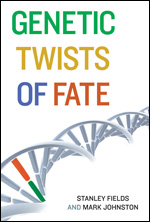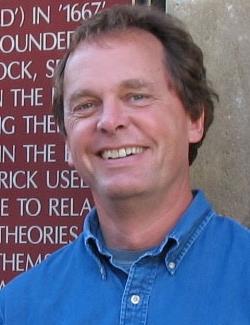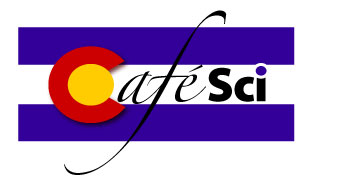About the topic
Bio
Get the Flyer (pdf)
About the topic
 Genetic Twists of Fate was published by the MIT Press in 2010. Here's what they say: "News stories report almost daily that scientists have linked a certain gene to a disease like Alzheimer’s or macular degeneration, or to a condition like depression or autism, or to a trait like aggressiveness or anxiety. Accompanying this remarkable progress in unraveling the genetic basis of disease and behavior are new technologies that are rapidly reducing the cost of reading someone’s personal DNA (all six billion letters of it). Within the next ten years, hospitals may present parents with their newborn’s complete DNA code along with her footprints and APGAR score. In Genetic Twists of Fate, distinguished geneticists Stanley Fields and Mark Johnston help us make sense of the genetic revolution that is upon us.
Genetic Twists of Fate was published by the MIT Press in 2010. Here's what they say: "News stories report almost daily that scientists have linked a certain gene to a disease like Alzheimer’s or macular degeneration, or to a condition like depression or autism, or to a trait like aggressiveness or anxiety. Accompanying this remarkable progress in unraveling the genetic basis of disease and behavior are new technologies that are rapidly reducing the cost of reading someone’s personal DNA (all six billion letters of it). Within the next ten years, hospitals may present parents with their newborn’s complete DNA code along with her footprints and APGAR score. In Genetic Twists of Fate, distinguished geneticists Stanley Fields and Mark Johnston help us make sense of the genetic revolution that is upon us.
Fields and Johnston tell real life stories that hinge on the inheritance of one tiny change rather than another in an individual’s DNA: a mother wrongly accused of poisoning her young son when the true killer was a genetic disorder; the mountain-climbing brothers with a one-in-two chance of succumbing to Huntington’s disease; the screen siren who could no longer remember her lines because of Alzheimer’s disease; and the president who was treated with rat poison to prevent another heart attack. In an engaging and accessible style, Fields and Johnston explain what our personal DNA code is, how a few differences in its long list of our DNA letters makes each of us unique, and how that code influences our appearance, our behavior, and our risk for such common diseases as diabetes or cancer."
Mark Johnston writes about his research interests:
Glucose sensing and signaling in yeasts: Glucose fuels life. It is the preferred carbon and energy source of most cells and the only source for some cells (e.g., brain cells). Because of this, cells have evolved sophisticated mechanisms for sensing glucose and responding to it appropriately. This is especially apparent in the yeast S. cerevisiae, which has several highly evolved regulatory mechanisms for sensing and utilizing the widely varying amounts of glucose it encounters during its lifetime. These regulatory mechanisms determine the distinctive fermentative metabolism of yeast, a lifestyle it shares with many kinds of tumor cells, and which humans have long exploited for production of food (bread) and my favorite beverage (beer). Our long-term goal is to understand how yeast cells sense and respond to glucose.
Comparative and Functional Genomics: A true understanding of cellular function will require knowledge of how the cell integrates many signals into its regulatory network and responds with a coordinated output. An important piece of this puzzle is identification of the proteins that regulate gene expression and the DNA sequences they recognize. We can identify potential regulatory sequences by comparative genomics and we can test these hypotheses with functional genomics. We are developing and implementing high throughput genetic and biochemical strategies for this purpose. Armed with the catalogue of regulatory proteins and their binding sites, we expect to be able to contribute to a comprehensive understanding of the regulatory network of this reference eukaryotic cell. This project offers opportunities to couple training in computational biology with experimental work.
Tree of Life: Showing how all organisms on Earth are related to each other has been a major goal of biologists since the time of Darwin. The “Tree of Life” illustration is critical to understanding when and how key traits— like the ability to cause or transmit harmful diseases—evolved. Progress has been slow, because the methods available for analyzing genes are costly, labor intensive and error-prone. Because of this, the goal of constructing a complete Tree of Life for the millions of species on our planet has seemed practically out of reach.
Writing in the Proceedings of the National Academy of Sciences of the USA, postdoctoral fellow Chris Todd Hittinger and Professor Mark Johnston and their collaborators at Vanderbilt University reported their use of new and very high throughput DNA sequencing technologies to identify hundreds of genes from 10 different species of mosquitoes. By comparing these genes they were able to determine the relationships of these mosquitoes, which are responsible for spreading malaria, yellow fever, and dengue hemorrhagic fever. The researchers describe how application of their approach will bring a complete Tree of Life on our planet within reach.
“There are thousands of mosquito species and more than 2 million species on our planet. Determining how they are all related is a massive undertaking, and we have provided a roadmap for how to achieve the dramatic cost and labor reductions that will be required to reach this important goal,” says Dr. Johnston. [The diagram on the left illustrates the genetic distances between 10 species of these, uh, stinging cousins.]
“We developed an experimental and computational approach that promises to greatly speed the process. We employed state-of-the-art “next-generation” DNA sequencing technology to sample hundreds of genes from 10 mosquito species. This tremendous quantity of data allowed us to accurately determine their evolutionary relationships with unprecedented efficiency and at such a low cost that it will soon bring Darwin’s dream of the Tree of Life within reach” added Hittinger. [CU press release]
Bio
 Mark Johnston, PhD, is Professor and Chair of the Department of Biochemistry and Molecular Genetics at the University of Colorado School of Medicine. Prior to his arrival here, he spent 25 years and 154 days at the Department of Genetics at Washington University School of Medicine in St. Louis. He holds a BA from the University of Wisconsin and a PhD in molecular biology from the University of California, Berkeley, and did a postdoctoral fellowship in the Biochemistry Department at Stanford University.
Mark Johnston, PhD, is Professor and Chair of the Department of Biochemistry and Molecular Genetics at the University of Colorado School of Medicine. Prior to his arrival here, he spent 25 years and 154 days at the Department of Genetics at Washington University School of Medicine in St. Louis. He holds a BA from the University of Wisconsin and a PhD in molecular biology from the University of California, Berkeley, and did a postdoctoral fellowship in the Biochemistry Department at Stanford University.
Johnston played a major role in the sequencing of the genome of bakers' yeast, the first eukaryotic genome to be deciphered, [how is it possible they didn't first do its close cousin, Brewer's yeast?] and he led an international effort to produce a complete gene deletion mutant collection of yeast that has been an important resource for researchers worldwide. His research has long focused on understanding how cells sense nutrients; more recently his lab has developed new genetic technologies to address questions in evolutionary and developmental biology.
He is the author of more than 100 papers and articles. His first book, Genetic Twists of Fate, co-authored with Stanley Fields, was published by MIT Press September 2010. A past president of the Genetics Society of America, Johnston is Editor-in-Chief of GENETICS (the first journal for the field, established in 1916). He received the 2008 George W. Beadle Award from the Genetics Society of America, was elected a fellow of the American Association for the Advancement of Science in 2006, and was the 2004 "B" flight champion at Gateway National Golf Links (St. Louis).
